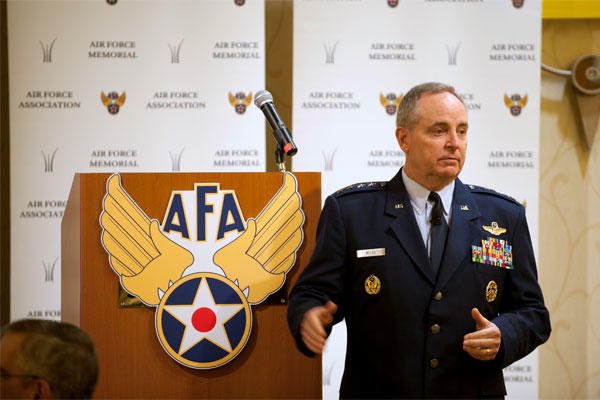ARLINGTON, Va. -- The Air Force's top officer reported on the growing strain sequestration has put on readiness, personnel and modernization to a group of civic and industry leaders attending the Air Force Association's monthly breakfast here, June 17.
Sequestration has hit the Air Force hard, said Air Force Chief of Staff Gen. Mark A. Welsh III.
Like the rest of the Defense Department, the Air Force has seen severe reductions in funding, leading to concerns about critical mission factors including the readiness of pilots and aircraft that aren't flying today.
"We've got folks sitting in fighter squadrons looking out of windows at aircraft that they haven't touched since the first of April," Welsh said.
Currently, the Air Force has stood down 33 squadrons, 12 of which are combat-coded fighter and intelligence, surveillance, and reconnaissance units. Another seven squadrons have been reduced to a basic mission capable rating.
Even before sequestration, there was a readiness crisis in the Air Force, Welsh said. The severe cutbacks required by the sequester will further downgrade force readiness beyond the current fiscal year if a budget agreement is not reached.
"We can't just all of a sudden accelerate training and catch up," he said. "It costs up to 2 1/2 times as much to retrain a squadron as it does to keep it trained."
Welsh emphasized the Air Force's efforts to continue to save where possible.
"We're looking for every option for where you can cut money -- every modernization/recapitalization program," Welsh said.
Regardless of reductions, the service cannot perform its air superiority mission with today's aging F-15 and F-16 fighters, and limited number of F-22s, the chief of staff said, making the new F-35 non-negotiable.
"When we truncated our F-22 buy, we ended up with a force that can't provide air superiority in more than one area at a time," Welsh said. "The F-35 is going to be part of the air superiority equation whether it was intended to be, originally, or not."
Welsh pointed out other countries will begin flying stealthy, highly-advanced fighters in the coming years, and if the U.S. doesn't have the aircraft to counter them in a high-end fight it will be in trouble.
There's nothing else that can do what the F-35 can, he said.
"Out there where people fight and die, for real, if a fourth-generation aircraft meets a fifth-generation aircraft, the fourth-generation aircraft may be more efficient, but it's also dead," Welsh said.


























